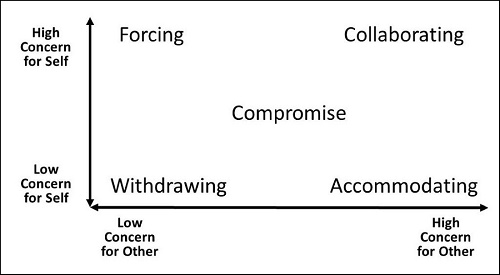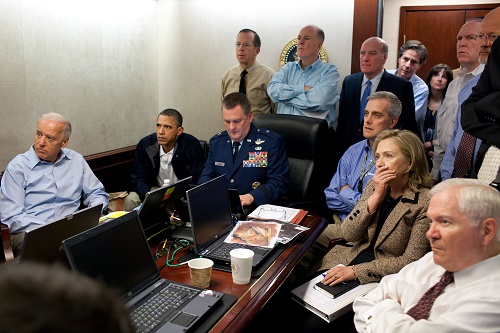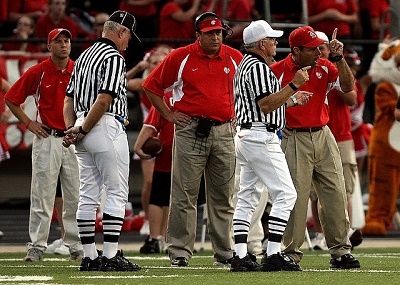6.2: Power and Conflict
- Last updated
- Save as PDF
- Page ID
- 79276
Learning Objectives
After completing this section, students should be able to:
- define interpersonal conflict and the influence of the relational and content dimensions.
- identify the six types of interpersonal conflict.
- describe the five ways interpersonal conflict is typically managed.
- illustrate best practices for conflict resolution.
- identify the principles and types of power in interpersonal relationships.
Conflict
When humans interact, there will be differences of opinions. Conflict, or different ways of viewing the same event or idea, is a perfectly normal part of the human condition. Each of us lives within our own field of experience and, as a result, we will have a range of perceptions on the same issue. Since conflict is normal and to be expected, the core issue for effective interpersonal communication is how conflict is addressed.
While it may seem counter-intuitive, conflict can actually be a healthy component of a quality relationship, depending on the type of conflict and how it is managed. Conflict can occur in the content dimension, the relationship dimension, or in both.
Conflict in the content dimension means we are disagreeing about an issue, a plan, an action, or something outside of the relationship itself. Perhaps we are trying to determine what movie to go see, whose parents to be with for a holiday, or where to go on vacation. A marker of content conflict is that it tends to be less emotionally charged than relationship conflict.
Conflict in the relationship dimension means we are disagreeing about the nature of the relationship itself. Perhaps she feels he does not value her, or he feels she is too controlling. Infidelities, disrespect, unresolved issues, anger, resentments, power struggles, or other such issues challenge the health of the relationship itself. Emotions are high in relationship conflict as we feel fear, insecurity, uncertainty, and rejection. Relationship conflict is very personal, while content conflict can be more impersonal.
A common scenario is where both dimensions are involved. Often when couples disagree in the content dimension, the conflict is actually a manifestation of something in the relationship dimension. Something as innocent as what movie to go see may actually be masking concerns about power and shared decision-making.
When partners address conflict, assuming it is done in a healthy way, the relationship can be strengthened and deepened. Some benefits of addressing and managing conflict include:
- Releasing tension: One person might be fretting over some issue or perceived insult. By processing the issue, the problem can be resolved before growing and festering. Instead of built up frustrations coming out in negative ways, the tension can be released in a healthy way.
- Learning to resolve conflict: As partners address conflict, they are learning the best way for them to handle conflict within the specific relationship. They can use the knowledge to address conflict later, always learning more about how best to handle it. This can be a very positive cycle of learning > applying > learning. The better the partners are at resolving conflict, the less relationship harm will come from the conflict.
- Growing closer: When partners make a commitment to address conflict, they are making a commitment to reinforce the relationship itself. Through conflict resolution, they engage in honest self-disclosure which can deepen and strengthen the relationship.
Types of Conflict
Ego Conflict: One of the most frustrating and destructive types of conflict is ego conflict. In an ego conflict, everything is taken very personally. The issue becomes “I want to win, and I want you to lose,” not resolving the conflict in a healthy manner. The person, or people, get defensive and the focus shifts from “resolving” to “winning.” In ego conflict, comments are taken as personal insults and defensiveness quickly arises.
Pseudo Conflict: Pseudo conflict is conflict that is superficial and easily resolved like a misunderstanding, misstatement, or other such minor disagreement. An example of a psuedo-conflict is if he says, “I thought you said 3:30,” and she replies, “No, it is at 3:00." Note how easily it is resolved, and how once it is resolved, the issue disappears quickly.

Belief (or Fact) Conflict: Beliefs are very basic views of what is true or false, exists or does not exist. For example, if one person believes a god exists and judges one's behavior, and the other person believes there is no god, they have a belief conflict. Belief conflicts do not have to be religious. They can be about a range of issues. For example, if he believes processed food is dangerous, yet she believes processed food is safe, they will have disagreements over what to eat. Often called “factual conflicts,” we disagree over what is true or accurate information.
Value (or Attitude) Conflict: Values refer to how we rank issues or actions in relative importance. We use our values as ways to measure the importance of things. For example, a young family with small children buying a new vehicle will most likely place safety as a very high value. When they look for a vehicle, safety ratings may play a key role in their final decision. However, for a single, young adult, the look of the vehicle may be more important than safety. Since our values vary, we consider the importance of things differently. We get into a value conflict when our relative value rankings do not match.
Action (or Policy) Conflict: Actions refer to behaviors or policies. An action conflict is a disagreement over what to do. For example, if Ruth and her husband have a disagreement over where to go on vacation, that is an action conflict. They may both agree they want to go to Glacier National Park, but disagree on where to stay, what to do, or how to devote their time. When parents run into issues disciplining children, they both agree they want to do what is best for the child, but they may come into conflict over which actions are most beneficial.
Meta-Conflict: A meta-conflict is a disagreement over how the conflict is being addressed. When a parent says, “Don’t talk back to me,” it is a meta-conflict; the issue is how the conflict is being addressed, not what the conflict is about. If one person says to the other, “Can I have my say?” it is a comment on how the conflict is being managed. The meta-conflict layers on top of the original conflict.
Managing Conflict
Before addressing specific ways to handle conflict, it is important to address defensiveness. Defensiveness arises when we feel our egos are being threatened. In effect, we put up a protective barrier to any incoming message, determined to repel, divert, or combat it in order to protect our personal sense of value and worth. Once we engage in defensiveness, behaviors will be based on protecting ego versus having honest, open communication. For example, having taught for 30 years, when someone suggests a better way to teach, Keith tends to become defensive. After all, he knows what he is doing, so he tends to minimize or ignore any suggestions. It does not matter how good the suggestions are. In Keith's drive to protect his ego, deflecting the criticism is more important than considering the other person may have a good point.
In resolving conflict, it is important we avoid triggering defensiveness in others, and equally important we not become defensive. As soon as defensiveness kicks in, any attempt at healthy conflict resolution is futile.

The way we manage conflict depends on a number of factors, but according to Froemling, Grice and Skinner (2011), we can summarize these as “concern for self” and “concern for other.” As shown in image 2, if we have a strong concern for ourselves and getting what we want or need, we will tend to manage conflict by pushing for things to go our way. If we have a stronger concern for the other, we will tend to manage conflict by focusing on what they want. We also can balance the two concerns, leading to other conflict management styles. The five common conflict management styles are:
Withdrawing/Avoiding: If we find the conflict unmerited, we may withdraw or avoid handling the conflict at all. We tend to withdraw when the conflict is not worth the tension and more trouble to engage in conflict management. If we predict broaching the subject will cause more difficulty than we are willing to engage in, we may withdraw. The danger with withdrawing is the conflict may become a larger issue if not addressed initially.
Accommodating: We accommodate when we let the other person have their way, regardless of what we want. Sometimes we do this because we are more concerned about the other party, or we have no strong feeling on the issue. If we do accommodate all the time, we risk being taken advantage of. The other person gets accustomed to getting their way, and we can start to resent the expectation.
Compromising: A compromise means both parties give and take to reach an acceptable decision. Neither party gets everything they want, but is willing to settle for as much as they can get. While compromise is often the best we can do, the danger is since neither party is fully satisfied, the frustrations over what was given up may grow and become intrusive.
Forcing: Forcing is making the other person do as we wish. In this case, getting our way is more important than the other person, and perhaps even the relationship itself, so we insist things be done as we wish. The danger with forcing is the potential for damage to the relationship, either temporarily or long-term.
Collaborating: When the parties have a sense of mutual respect and concern, more focused on maintaining the health of the relationship than just winning, they can engage in collaboration. They work jointly to find a mutual decision with which both are comfortable. This is not compromise; no one is giving up anything. They are coming to a common agreement on the best resolution for both.
Conflict Resolution
Many of us do not like addressing conflict; we tend to fall back on whatever conflict management style we are most comfortable with using. The list below outlines a relatively simple and straightforward way to talk about conflict in a healthy manner:
- Let the other person express their feelings and concerns on the issue without interruption, except when necessary to ask for clarification.
- Paraphrase back to the person and try to understand their concerns. This is a perception-check, to make sure we understood correctly and demonstrates we are listening and understanding their position.
- Express our feelings and concerns.
- Identify the core point of difference.
- Discuss the core difference, working to understand each other’s point of view.
- Identify and implement a solution acceptable to both people.
While engaging in the process, it is very important to minimize emotion and avoid defensiveness. Once emotion and defensiveness take over the interaction, the chances of resolving the conflict are minimalized.
We must also operate with integrity, which means we say what we need to say, and we act consistently with what we say. If we fail to express our thoughts completely, we may find the resolution is superficial or not really targeted on our concerns. Once we and our partner reach a resolution, it is important to follow through. Agreeing to something, then not following through, inflames the conflict, versus resolving it.
Sometimes a conflict is significant but difficult to solve or even to talk about. When the issue and the relationship are important, bringing in a mediator may help. A mediator must be a neutral and impartial party. Friends or family members are not qualified to mediate because of their inherent bias toward the situation or the parties. Gaining an outside perspective may help those in conflict to see the situation anew and work toward collaborating on a resolution.
Power and Influence
In all relationships, there are power dynamics. No matter how equal we may feel, power does come into play. Power is our ability to influence or control another person. It may be as mild as trying to persuade our friends to see the movie we want to see or as forceful as loudly demanding a refund for an improperly cooked steak. Power is not inherently bad; how it is used is the core issue.
Dynamics about power to keep in mind include:
- Power is perceived. When a person has power over us, it is because we perceive the person to have power over us; we give them that power. For example, a boss has power over us because we choose to work in that setting. A spouse has power over us in some areas because we respect their expertise in those areas. Police officers have power because society gives them power. If we let our fear of a person control us, we are giving power to the person to control us. This does not mean we can simply take away the power without consequence. If we decide we do not respect the power our boss has over us, the consequence may be losing our job. If we do not respect the power we have collectively given police officers, we may find ourselves in jail. The power a person has over us is something we give to them.
- Power follows the principle of least interest. The person with the least interest in the resolution has the most power. The more we want something, the more power we give the other person. If Jon really wants Dianne to like him, but Dianne is only mildly interested, he will do whatever she asks; Dianne has a lot of power over Jon. If Ian is considering a new vehicle, but is in no rush to buy, he has power over the salesperson. As long as Ian is comfortable walking away from a deal, he has the advantage. If Ian really wants to buy the specific car today, the salesperson will have more power over him.
- Power is used intentionally and unintentionally. Nearly every day we are in situations in which decisions need to be made in conjunction with others. We reason and plead and negotiate to get things accomplished, to get our way or to avoid unpleasant tasks. Friends influence each other, as do parents and children. For example, on Friday night, Elise talks Blake into going bowling instead of watching a movie. Twelve-year old Mara does not eat the new cereal her dad buys, so he does not buy it again.
- The more power we have, the less we have to abide by rules, norms, and expectations. No matter how egalitarian (equal) we like to think we are, people with more power have the ability to set and alter rules and norms. Humans are very status oriented; we quickly determine our "place" in the order of things. Leaders at the top, set the expectations and the followers of lower status, are expected to adhere to those expectations. In social groups, those higher in status can suggest things that those of lower status would be shunned for doing. In the workplace the rules seem to apply differently as one goes up the organization’s hierarchy. In the classroom, instructors make rules students have to abide by, and the instructor can change the rules as they see fit.
- “With great power comes great responsibility.” This quotation (often attributed to Spiderman, but actually comes from Voltaire in 18th century France) means people who have higher power have a greater ethical obligation to use their power wisely. Parents have enormous power over their children, and we expect parents to use their power thoughtfully, in a healthy manner, and to raise a responsible person. Unfortunately we hear of parents abusing the power, through physical, sexual, emotional, or mental abuse. In a classroom, an instructor has a great responsibility to treat all students fairly and equitably, minimizing favoritism, and working to insure all students have the same opportunities to succeed. Police officers are held to very high standards of conduct due to the sheer power they have over citizens. As power increases, our obligations to use power ethically and judiciously also increases.

Types of Power
Verderber and MacGeorge (2016) identify five types of power we encounter as we navigate our relationships.
Coercive power is using threats to get one's way. Coercion is threatening harm, either physically or psychologically, to force the other person to do as we wish. The classic physical threat, “Do this or I will hit you,” is physical coercion, while statements such as, “If you loved me…” is psychological coercion. The degree of coercive power one has depends on two variables: how much the other person fears the threat, and how likely the threat will be followed through. If a parent regularly threatens to take away a favorite toy to get a child to act a certain way, yet never does, the likelihood of the threat coming true diminishes, the power diminishes. If the child does not like the toy, the threat is less powerful.

Reward power is using the offer of some desired item or action to influence a person’s actions. Many students are motivated by this sort of power, wanting the reward of a high grade for their work. Offering a worker a bonus for high quality work can serve to motivate the individual to higher levels of performance. Reward power is only as strong as the desire for the reward. If a student is perfectly happy with a C, the instructor has far less reward power over them than over the “gotta get an A” type of student.

Referent power is interpersonal power. Some people have power over us because we like them and want to have a relationship with them. We are far more likely to do as our partner asks because we want to maintain an intimate relationship with them. With other, more transient relationships, the degree of referent power is minimal. Referent power is strongest with those we wish to be connected with, and with whom the relationship is very important. Social groups usually have a leader or two. The other members will typically go along with the ideas and suggestions of the leader to stay in the group, be accepted, and feel a sense of connection and belongingness to the group.

Legitimate power is power given by an institution, social structure, or governmental entity. We believe the source of the power has the authority to confer power on individuals. We perceive police officers having power because our judicial system attributes power to them. We perceive teachers as having power over students because our educational system defines the power relationship in that way. Players accept that sports officials, as in image 7, have power due to their defined role in the game. Power is still given, but in this case it is given by an organization, not an individual.

Expert power is power given to people we think know more than we do about specific topics. We are more likely to trust and be influenced by our physicians because we believe they know far more than we do about proper medical care. If the doctor says we should take a medication for our health, we will most likely do so. However, if our perception of the doctor's expertise drops, our willingness to act on the directions given also falls; we are giving less power because we see the doctor as less of an expert. We may have experienced a person who presents themselves as an expert, but as we got to know them, we realized they did not know as much as they appeared to. As a result, the amount of expert power we give them drops.

Key Concepts
The terms and concepts students should be familiar with from this section include:
Conflict
- Content dimension and Relationship dimension
- Types of conflict
- Ego
- Psuedo
- Belief
- Value
- Action
- Meta
- Managing conflict
- Defensiveness
- Withdrawing/Avoiding
- Accommodating
- Compromising
- Forcing
- Collaborating
- Conflict resolution
Power and Influence
- Dynamics of power
- Perceived
- Principle of least interest
- Used intentionally and unintentionally
- Adherence to rules, norms, and expectations
- Great responsibility
- Types of power
- Coercive
- Reward
- Referent
- Legitimate
- Expert
References
Froemling, K.K., Grice, G.L., & Skinner, J.F. (2011). Communication: The handbook. Boston, MA: Allyn and Bacon.
Verderber, K.S., & MacGeorge, E. L. (2016). Inter-Act: Interpersonal communication concept, skills, and contexts (14th ed.). New York, NY: Oxford University Press.


